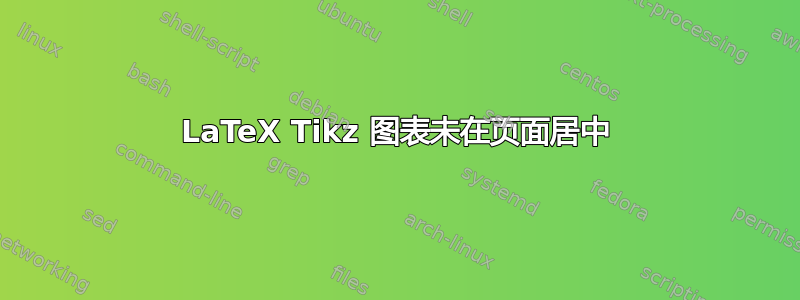
我是 LaTex 的新手,所以如果这太基础了,请原谅我。我使用 Tikz 创建了一个图形,但不确定如何让它在页面上居中。我试过了,\center但\begin{centered}这些都不能解决问题。正如另一个问题所建议的那样,我尝试将它做成一个图形,但如果有什么的话,那就是它让情况变得更糟了,把它推到了文本上方!
我用它\usepackage{showframe}来演示这个问题,并显示图形比页面宽。对于像我这样的新手来说,任何建议都很重要 :)
文档截图:
用于创建它的 LaTex:
% ADAPTED FROM:
% Author: Robert Felty
% Source: http://blog.robfelty.com/2007/02/14/pgf-gallery
% Model structure from Rumelhart \& McClelland (1986, p .222)%
\documentclass{article}
\usepackage{tikz}
\usetikzlibrary{arrows}
\usepackage{showframe} % To demonstrate issue
\begin{document}
\pgfdeclarelayer{background}
\pgfsetlayers{background,main}
\tikzstyle{information text}=[text badly centered,font=\small,text width=2.6cm]
\section{Simple Neural Network}
\begin{figure}
\begin{tikzpicture}[scale=.8]
\foreach \xa / \xb in {1 / 5, 5 / 9}
\foreach \ya / \yb / \yc in {2 / 3 / 4, 3 / 4 / 2, 4 / 2 / 3}
{
\draw (\xa,\ya) -- (\xb,\ya);
\draw (\xa,\ya) -- (\xb,\yb);
\draw (\xa,\ya) -- (\xb,\yc);
}
\node at (1,1.3)[information text]{...};
\node at (5,1.3)[information text]{...};
\node at (9,1.3)[information text]{...};
\draw[->] (1,0.4) node[below, information text]
{Input Neurons (Pixels of Image) $\times$ 784} -- (1,1);
\draw[->] (5,0.4) node[below,information text]
{Hidden Neurons $\times$ 100} -- (5,1);
\draw[->] (9,0.4) node[below,information text]
{Output Neurons (Confidence of each digit) $\times$ 10} -- (9,1);
\draw (3,5) node[information text] { Input $\rightarrow$ Hidden Weights };
\draw (7,5) node[information text] { Hidden $\rightarrow$ Output Weights };
\foreach \y in {2,3,4} {
\draw[->] (-0.5,\y) node[left, information text]{} -- (0.7,\y);
\draw[->] (9.3,\y) node[left, information text]{} -- (10.5,\y);
\foreach \x in {1,5,9}
\filldraw[fill=white] (\x,\y) circle (0.3);
}
\end{tikzpicture}
\caption{The structure of the network.}
\end{figure}
\end{document}
答案1
问题只是您在图表左侧添加了一些空节点,这些节点在输出中不可见,但确实会影响边界框。如果您添加draw到样式中information text,您将获得以下输出:
注意左侧的三个空框。它们是在循环中生成的\foreach,因此要删除它们,请将循环中的前两行修改为
\draw[->] (-0.5,\y) -- (0.7,\y);
\draw[->] (9.3,\y) -- (10.5,\y);
即删除node[left,information text] {}。
之后,\centering在 后添加\begin{figure},得到如下结果:
\documentclass{article}
\usepackage{tikz}
\usetikzlibrary{arrows}
\usepackage{showframe} % To demonstrate issue
\begin{document}
\pgfdeclarelayer{background}
\pgfsetlayers{background,main}
\tikzset{information text/.style={text badly centered,font=\small,text width=2.6cm}}
\section{Simple Neural Network}
\begin{figure}
\centering
\begin{tikzpicture}[scale=.8]
\foreach \xa / \xb in {1 / 5, 5 / 9}
\foreach \ya / \yb / \yc in {2 / 3 / 4, 3 / 4 / 2, 4 / 2 / 3}
{
\draw (\xa,\ya) -- (\xb,\ya);
\draw (\xa,\ya) -- (\xb,\yb);
\draw (\xa,\ya) -- (\xb,\yc);
}
\node at (1,1.3)[information text]{...};
\node at (5,1.3)[information text]{...};
\node at (9,1.3)[information text]{...};
\draw[->] (1,0.4) node[below, information text]
{Input Neurons (Pixels of Image) $\times$ 784} -- (1,1);
\draw[->] (5,0.4) node[below,information text]
{Hidden Neurons $\times$ 100} -- (5,1);
\draw[->] (9,0.4) node[below,information text]
{Output Neurons (Confidence of each digit) $\times$ 10} -- (9,1);
\draw (3,5) node[information text] { Input $\rightarrow$ Hidden Weights };
\draw (7,5) node[information text] { Hidden $\rightarrow$ Output Weights };
\foreach \y in {2,3,4} {
\draw[->] (-0.5,\y) -- (0.7,\y);
\draw[->] (9.3,\y) -- (10.5,\y);
\foreach \x in {1,5,9}
\filldraw[fill=white] (\x,\y) circle (0.3);
}
\end{tikzpicture}
\caption{The structure of the network.}
\end{figure}
\end{document}
答案2
显然,您的图片并不对称于其自身的中心。我曾经\framebox想象过 的边界tikzpicture。
% ADAPTED FROM:
% Author: Robert Felty
% Source: http://blog.robfelty.com/2007/02/14/pgf-gallery
% Model structure from Rumelhart \& McClelland (1986, p .222)%
\documentclass{article}
\usepackage{tikz}
\usetikzlibrary{arrows}
\usepackage{showframe} % To demonstrate issue
\begin{document}
\pgfdeclarelayer{background}
\pgfsetlayers{background,main}
\tikzstyle{information text}=[text badly centered,font=\small,text width=2.6cm]
\section{Simple Neural Network}
\begin{figure}
\centering % <------------------- Added
\framebox{ % <------------------- Added
\begin{tikzpicture}[scale=.3]
\foreach \xa / \xb in {1 / 5, 5 / 9}
\foreach \ya / \yb / \yc in {2 / 3 / 4, 3 / 4 / 2, 4 / 2 / 3}
{
\draw (\xa,\ya) -- (\xb,\ya);
\draw (\xa,\ya) -- (\xb,\yb);
\draw (\xa,\ya) -- (\xb,\yc);
}
\node at (1,1.3)[information text]{...};
\node at (5,1.3)[information text]{...};
\node at (9,1.3)[information text]{...};
\draw[->] (1,0.4) node[below, information text]
{Input Neurons (Pixels of Image) $\times$ 784} -- (1,1);
\draw[->] (5,0.4) node[below,information text]
{Hidden Neurons $\times$ 100} -- (5,1);
\draw[->] (9,0.4) node[below,information text]
{Output Neurons (Confidence of each digit) $\times$ 10} -- (9,1);
\draw (3,5) node[information text] { Input $\rightarrow$ Hidden Weights };
\draw (7,5) node[information text] { Hidden $\rightarrow$ Output Weights };
\foreach \y in {2,3,4} {
\draw[->] (-0.5,\y) node[left, information text]{} -- (0.7,\y);
\draw[->] (9.3,\y) node[left, information text]{} -- (10.5,\y);
\foreach \x in {1,5,9}
\filldraw[fill=white] (\x,\y) circle (0.3);
}
\end{tikzpicture}
} % <------------------- Added
\caption{The structure of the network.}
\end{figure}
\end{document}
编辑
按照建议Torbjørn T.(添加draw)您会看到占据空间的额外空框。
\tikzstyle{information text}=[text badly centered,font=\small,text width=2.6cm,draw]







